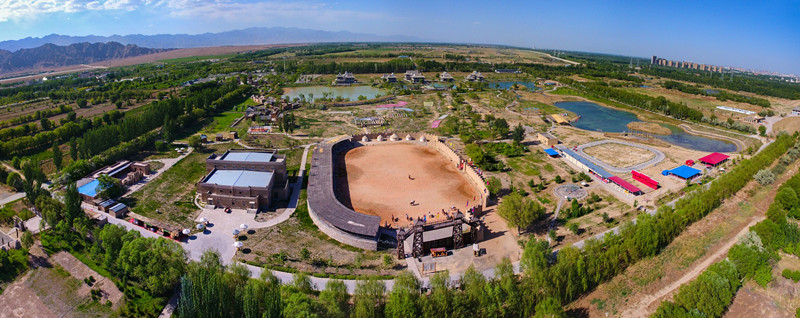Xixia district

Xixia Cultural Park [Photo/ycxixia.gov.cn]
Xixia is a district in the west of Yinchuan, the capital city of northwest China's Ningxia Hui Autonomous Region. With an area of 1,129.3 square kilometers, it is connected to the Baotou-Lanzhou Railway and borders the counties of Yongqing and Helan to its south and north respectively.
As the largest county-level administrative area in Yinchuan, the district is composed of two townships and seven sub-district offices and has a population of 450,000. There are 123 government agencies and public institutions, 416 private firms and social organizations.
The district is positioned to be an inland highland for innovation-driven development, a core area for the development of a premium wine industry and a key place in the preservation of regional culture. It will stick to the integrated development between urban and rural areas and give full play to six major development platforms: the Yinchuan-Zhongguancun Innovation and Entrepreneurship Technological Center, the Yinchuan Highway and Railway Center for International Logistics Services, the Yinchuan Economic and Technological Development Zone, the Grape Cultural and Tourism Corridor in the East of Mount Helan, the University Town and the West Square of the Yinchuan Railway Station. In giving full play to these areas, the district aims to build a new whole-region sci-tech city.
The new sci-tech city will feature the building of a demonstration area for strategic emerging industries, the development of opening-up and diversified multimodal transportation, the formation of functional areas for modern equipment manufacturing and new materials industries, the cultivation of a high-speed railway business circle and the building of a personnel training base.
Xixia is a historical and cultural district. It was founded in the year of 678 and was part of Huaixian county during the Tang Dynasty (618-907). Li Yuanhao (1003-1048), a leader of the Dangxiang ethnic people in northwest China, chose the place as the capital of his Western Xia Dynasty (1038-1227). The separatist regime left rich historical and cultural heritage in place. The central government of the Ming Dynasty (1368-1644) changed its name to Ningxia city and designated it as one of nine major strategic places in the border areas. This location became one of the key cities in northwest China during the Qing Dynasty (1644-1911).
Xixia is an old industrial base in the autonomous region. As a former industrial base built in the 1960s, the district has become an industrial cluster of heavy industries over the decades. Right now, there are 78 industrial companies in the district, accounting for 16.8 percent of the total number in Yinchuan. A total of 19 of those firms are under its jurisdiction, while the rest belong to the economic and technological development zone.
Xixia is a highland for innovation-driven development. It is home to 17 universities and colleges, which include Ningxia University and North Minzu University, and about 150,000 students. In addition, there are two national-level engineering laboratories and 10 provincial-level research institutes in the district.
Xixia is a core area for the development of a premium wine industry. The eastern foot of Mount Helan has been recognized as a "golden belt" in the plantation of grapes and has been designated as a national protection zone for agricultural products with geographical indications. Therefore, the district enjoys natural advantages in the development of a wine industry.
Xixia is situated at the center of the western golden tourism line in Ningxia. The district boasts rich tourism resources, which are represented by 12 national A-level scenic spots, 34 agritainment and ecological parks, and three star-level hotels.
Xixia is a hub of transportation and logistics services. The district enjoys an advantageous location. The Yinchuan West Railway Station and the South Freight Station of the Yinchuan Railway Station are both situated in the district, and the Baotou-Lanzhou Railway also passes through. According to the national outline on the development of high-speed railways, Yinchuan Railway Station will be the originating station of the Yinchuan-Xi'an High-speed Railway, the Baotou-Yinchuan High-speed Railway, the Bayanhot-Yinchuan Railway, the Taiyuan-Zhongwei-Yinchuan Railway and the Baotou-Lanzhou Railway.
Xixia is an international highway and railway logistics center. The Yinchuan Highway and Railway Center for International Logistics Services, which covers an area of 20,685 mu (13.79 square kilometers), is committed to developing logistics and storage services, logistics and delivery services, logistics and financing services, international trade services, the trade and exhibition of bulk commodities. In addition, it will also provide supporting services such as storage management, information services, redistribution, and packaging and processing. It is a key link in the building of a national commercial network specified in the 13th Five-Year Plan period (2016-2020), a large-scale and comprehensive logistics park in Yinchuan, one of China's first 11 transportation and logistics projects, and a pilot national demonstration project for multimodal transportation.
Xixia is fostering new leading industries. The district has grasped opportunities brought about by the construction of a Yinchuan metropolitan area and has focused its business attraction on such factors as high-end equipment manufacturing, modern services, commercial logistics, new materials and new energy, wine, healthcare, education and cultural tourism in a drive to build it into a new sci-tech city.

 Yinchuan Wine-producing Area at the eastern foothills of Helan Mountains
Yinchuan Wine-producing Area at the eastern foothills of Helan Mountains A promising Sci & Tech center in NW China
A promising Sci & Tech center in NW China Party building stories in Yinchuan's Xixia district
Party building stories in Yinchuan's Xixia district